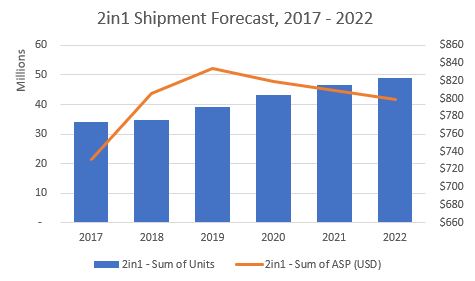It seems that 2-in- PCs are having a bit of a resurgence these days as every major PC manufacturer offers a variety of screen sizes, features, materials, and product lines with the ability to use the device both as a notebook PC as well as a tablet.
Though it may not seem like it, there has been a lot of innovation in the 2-in-1 market in these past few years. To put things in perspective, the market arguably kicked off when Microsoft launched the original Surface Pro back in 2013. At the time, tablets were media consumption machines and Microsoft’s push to make the tablet more like a productive PC was off to a rocky start. The company didn’t really get into its stride until the third generation Surface Pro in 2014 and soon after, Apple, the tablet market leader, launched its first 2-in-1 product: the iPad Pro.
Though in reality, even older iPads supported the use of third party keyboards and Apple was well on its way to taking the tablet from the lap to the desk or from the home to the office. Nevertheless, the iPad Pro brought some much-needed attention to the market. An increasing amount of tablet brands were launching detachable devices and even traditional PC makers were offering more convertible and detachable form factors.
Since then, Microsoft and Apple have championed the 2-in-1 category through their devices and software, though both took very different approaches. The Surface attempted bringing the desktop experience to mobile users while the iPad Pro took the mobile experience and scaled it up to a larger screen size and more capable hardware, which quickly helped them supplant other vendors. Now, once again, another major tech brand has fully committed to the market as Google launched their second ChromeOS-based 2-in-1: the Pixel Slate.
Google has two separate operating systems each with its own strengths. Chrome OS offers a desktop class browser and with it come productivity apps that are powerful and capable enough to compete with Microsoft office. In addition to ChromeOS, Google has Android — an OS that has been the market leader when it comes to mobile first operating systems. With an installed base of over three billion devices and a wide app selection, the Android ecosystem has always offered users a very compelling smartphone experience. And with the latest ChromeOS devices, Google is trying to combine the strengths of its two operating systems.
Why Do 2-in-1 PCs Matter?
But even with all these changes in the market, shipments for 2in1s has been slowing; in fact, it declined in 2018Q2 and 2018Q3. So, you might ask yourself, why is IDC even writing a blog post about this? And should I even care?
The short answer is that you definitely should care because there’s a good chance your next “computer” will be a 2in1. Not only is IDC expecting double digit growth in the category in the years to come, but at least in 2019, we’re expecting average selling prices (ASP) to go up. You might want to consider making that purchase sooner rather than later. And in case you’re reading this from an enterprise perspective thinking this doesn’t apply to you, think again – because we’re also seeing that type of growth in the commercial segment.

Consumer Needs are Driving Change in 2-in-1s
These devices are changing the way we think of work and play. It’s not the case anymore where consumers are buying a tablet for home and media consumption and also getting a laptop to be more productive. Not only is consumer behavior changing, but the way they work is also changing, sparking change in the enterprise. Companies don’t just rely on Office (including its deluge of apps) and email anymore. They now have to incorporate additional apps and services such as WhatsApp, Trello, or Slack, making it even more important for companies to support an increasing mobile form factor and OS.
Amongst the various platforms for 2-in-1s, Windows is expected to lead due to the support from multiple vendors and a large enterprise audience that still favours the OS. However, both Google and Apple are expected to gain market share and each offers its own benefits. Apple’s continued push to make the iPad the computer of tomorrow has slowly helped transform iOS from a simple mobile OS to a far more feature rich and capable platform. And to date, it’s essentially the only choice for someone who’s looking for cellular connectivity built in. While iOS may not appeal to all, it certainly gets most of the job done well. Meanwhile, Google’s foray into this space is one that that hasn’t been welcomed with open arms as the implementation of Android apps in ChromeOS is far from seamless and leaves a lot to be desired.
Despite that, I still remain optimistic for a couple of reasons. First, from a hardware perspective, Chromebooks have been consistent and affordable, but also a bit bland. But that’s changing as Google begins to loosen their restrictions around hardware requirements and design. In fact, devices like the Pixel Slate or even HP’s Chromebook X2 are great examples of this and a welcome step in the right direction.
Second, Google has managed to maintain an extremely rapid OS update cycle. This level of agility and dedication to quick upgradeability is a strength for Google and its hardware partners. That’s not to say it doesn’t have any adverse effects but Google has learned a lot (mostly about what not to do) about deploying operating systems at scale though its Android efforts and hence the approach used for ChomeOS is quite different.
What Buyers are Looking for in 2-in-1 PCs
My optimism for Google and Apple isn’t to say that their platforms are on track to lead in the 2-in-1 market. Rather it’s to show that no matter their issues today, neither should be counted out. And regardless of the platform used, vendors looking to build new devices or end users looking to purchase new ones should take into consideration a few things:
- Pen input: this is already table stakes in 2018 but the importance grows in the future as screens on these devices increase in terms of size and resolution. With that comes the need for a precision pointing tool, especially when using the device in tablet mode.
- Versatile I/O: USB-C is on its way to ubiquity but the reality is most business and consumers are still years away from upgrading all their hardware and accessories to support this new standard. Including legacy ports like a headphone jack or a display output can go a long way in ensuring satisfaction and keeping buyer’s remorse to a minimum.
- Services: will all the apps and services you use on a regular basis work on your new device? If you have a need for legacy software, maybe a new Windows 2-in-1 is right for you. But maybe if all your work is done through the web then a more affordable Chrome 2-in-1 may be the best route.
- Cellular Connectivity: while iPads lead the way at the moment, upcoming advancements from Qualcomm and Microsoft will make upcoming Windows based 2-in-1s a viable option. Even chromebooks makers are offering more SKUs with cellular connectivity as an optional feature.
Learn more about what is on the horizon for technology, devices, and IoT: watch the IDC FutureScape: Worldwide Connected Devices 2019 Predictions on demand now:




